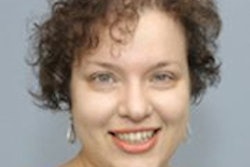
LONG BEACH, CA - Implementing ultrasound DICOM structured reporting tools yields a significant improvement in dictation times over conventional reporting methods, according to a study presented on Friday at the Society for Imaging Informatics in Medicine (SIIM) meeting.
Using DICOM structured reports from ultrasound systems to automatically fill in measurement values in dictation templates significantly reduces dictation time, representing potential time savings of nearly seven days a year for the institution, said presenter Dr. Steven Horii from the University of Pennsylvania Health System.
While most ultrasound vendors have included image measurements, checklist items, and derived values in DICOM structured reports for years, PACS and dictation system vendors -- for the most part -- have not been able to process these items, Horii said.
Many ultrasound systems have numeric observation data such as organ sizes, fetal measurements, lesion measurements, and Doppler values, but until recently all of these had to be dictated by the reporting physician. Some exceptions, however, include obstetrical reporting systems, cardiology reporting systems, and vascular systems.
"Some of these use screen capture -- they basically capture whatever's on the ultrasound screen and use that as a report -- and others take the measurements [from the ultrasound systems] and may or may not use DICOM structured reporting," he said.
Some non-DICOM structured reporting systems may have the sonographer complete a checklist or form on a computer separate from the ultrasound scanner, according to Horii.
Most PACS vendors will store an ultrasound DICOM structured report if they receive it, but they do not process it. However, some vendors will now process the ultrasound DICOM structured report and format the observation data for speech recognition or other dictation systems. The dictation system vendors tend not to be able to directly accept DICOM structured reports.
Experience
After their institution's ultrasound miniPACS vendor expressed an interest in being able to process the ultrasound DICOM structured report, format the results, and pass them on to the speech recognition system, the researchers began testing this in late 2012, Horii said.
Initial work involved obstetrical studies, as these involve numerous measurements that have to be dictated.
There were some issues that needed to be addressed, such as rounding. For example, their ultrasound machines included many digits beyond significant figures (such as 23.572343 cm, which is rounded to 23.6 cm). In addition, there were time conversion and unit conversion problems. For example, 56.7 days needed to be changed to eight weeks, one day, and metric units had to be converted to pounds and ounces, according to Horii.
While the ultrasound machine screen displays included these various conversions, scaling, and some rounding, the scanners tend to insert unprocessed observation values into the DICOM structured report. As a result, the acceptor of the report has to perform this conversion before sending the values to the speech recognition system, Horii explained.
After the ultrasound scanners and miniPACS were set up to generate and accept DICOM structured reports, dictation templates were developed to include the merge fields, which included the ultrasound data from the structured report, he said. The mapped merge fields were then sent from the miniPACS to the speech recognition system and filled in the dictation templates automatically.
The research team collected all ultrasound reports from March 1, 2013, through February 29, 2014. They also tracked subsets of first-trimester and second/third-trimester obstetric reports. They searched the reports by exam description and recorded when the dictation started and when it was ready to be finalized.
After testing their hypothesis only for first- and second/third-trimester reports, the researchers discovered that the times were not normally distributed and they had outliers that greatly added to the standard deviation and swamped any differences, Horii said.
Based on prior research from when the institution had transitioned from digital dictation to speech recognition, the group had determined that any dictation time over 12 minutes was most often due to interruptions in dictation. No uninterrupted obstetric report took longer than 12 minutes.
Lower dictation times
After outliers were culled from the study sample, the resulting dataset included 7,386 conventional reports, 2,356 autofill reports, 276 first-trimester conventional reports, 178 first-trimester autofill reports, 352 second/third-trimester conventional reports, and 456 second/third-trimester autofill reports.
| Dictation time (in minutes) | ||||
| Conventional macros (median) | Autofill macros (median) | Conventional macros (mean) | Autofill macros (mean) | |
| All reports | 6.24 | 5.91 | 6.71 | 6.49 |
| 1st trimester | 7.49 | 4.44 | 7.64 | 5.29 |
| 2nd/3rd trimester | 8.58 | 6.51 | 8.45 | 6.96 |
The differences between the conventional and autofill macros were statistically significant for the median dictation times for all reports (p = 0.0293), first-trimester reports (p < 0.0001), and second/third-trimester reports (p < 0.0001). The differences were also significant for the mean dictation times for all reports (p = 0.0154), first-trimester reports (p < 0.0001), and second/third-trimester reports (p < 0.0001).
The mean reductions in time represented mean savings of 0.22 minutes (a 3.3% faster time) for all reports, 2.35 minutes (a 30.7% faster time) for first-trimester reports, and 1.49 minutes (a 17.6% faster time) for second/third-trimester reports. For the all-reports category of 22,654 reports with a mean savings of 0.22 minutes, that represents total time savings of 4,964 minutes, or 6.9 days.
Horii noted that the all-reports category includes many studies that do not use autofill, as they either have no values to fill -- such as deep venous thrombosis studies -- or are performed on machines that do not have the DICOM structured report set to capture the measurements they use.
He acknowledged a number of limitations to the study, including the potential bias from excluding outliers. In addition, they did not evaluate the effect of autofill macros on error rates and used a time measure that did not record the actual time spent dictating a study.
Nonetheless, the use of DICOM structured reports to autofill measurement values significantly lowered dictation time.
"We believe it also reduces errors, but we don't have proof of that yet," Horii said. "It reduces some sonographer effort. They used to have to fill out these paper sheets with some of the values in it, and they no longer have to do that."




















